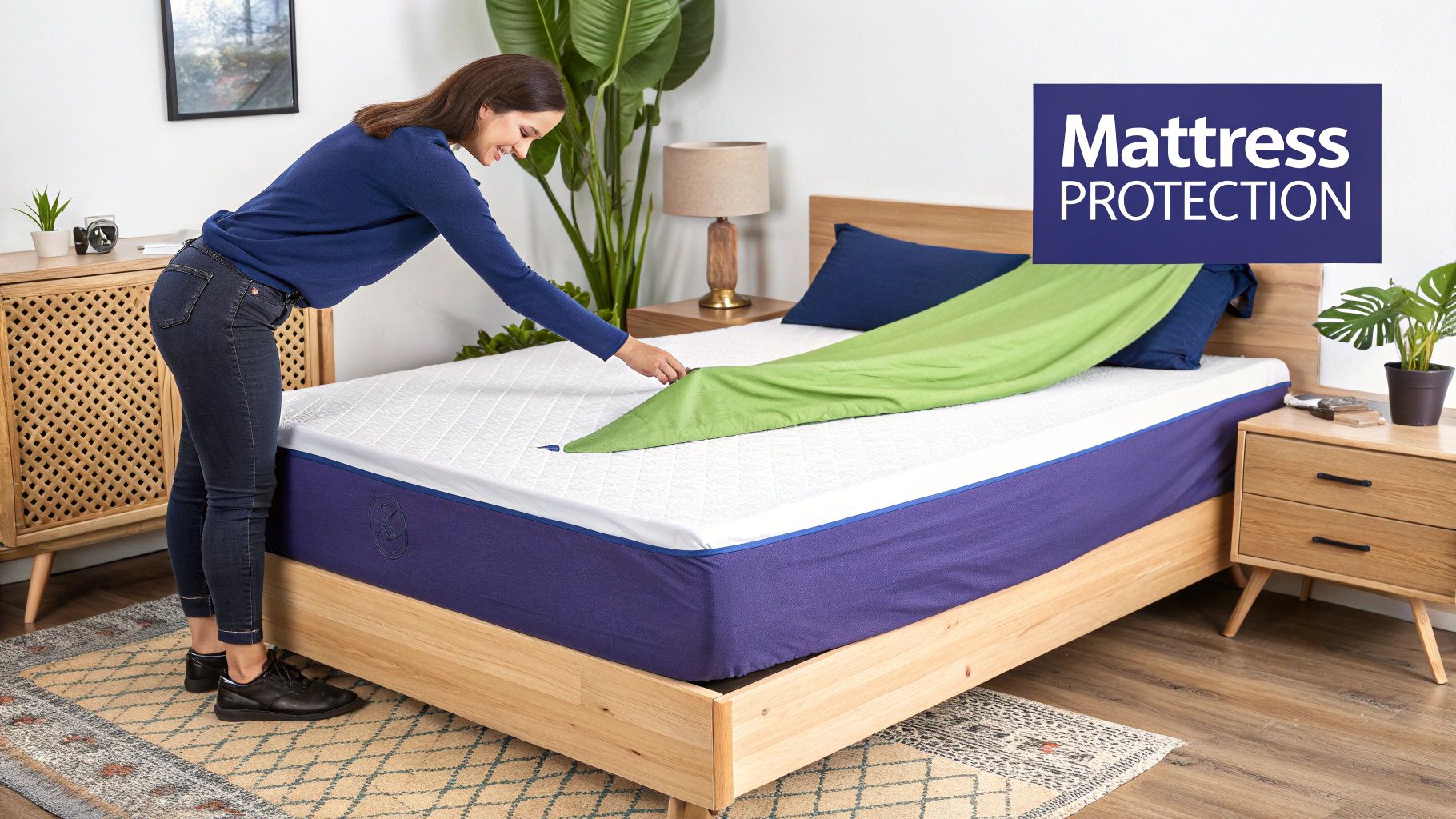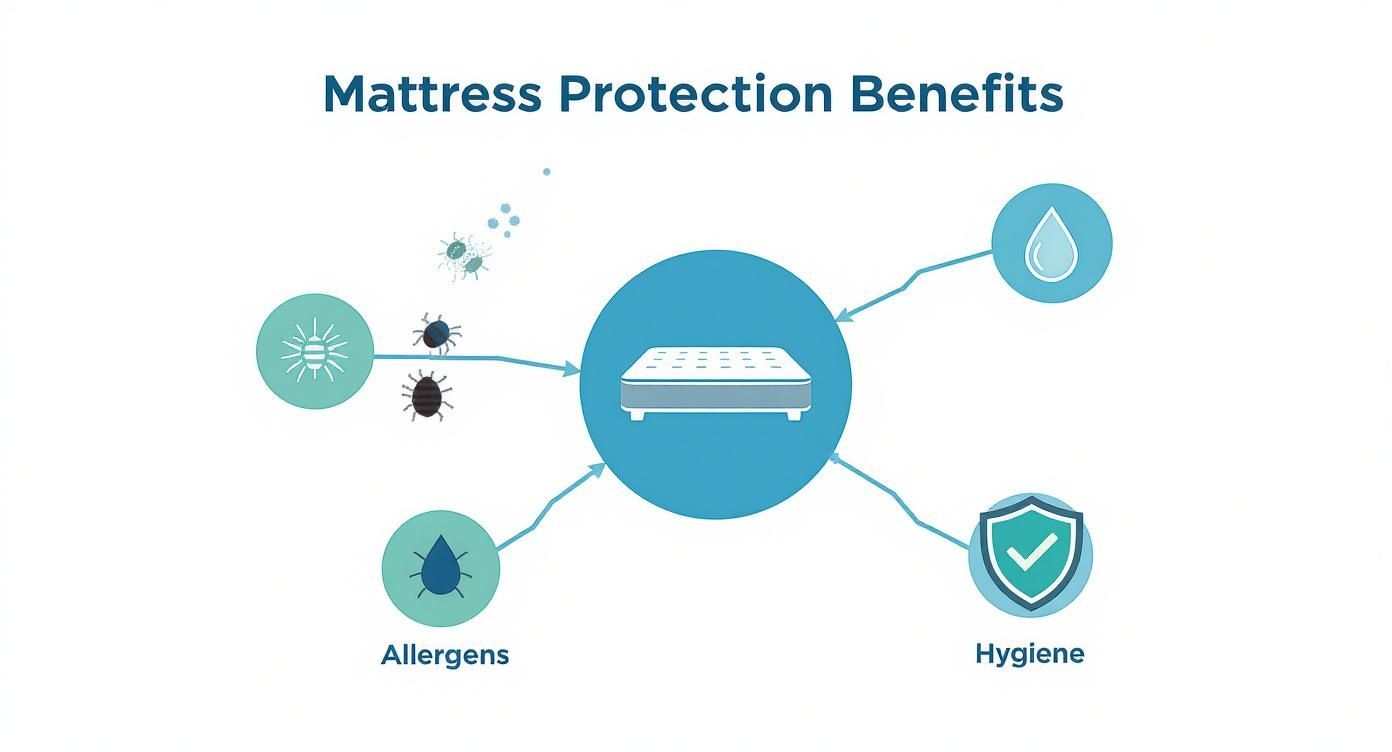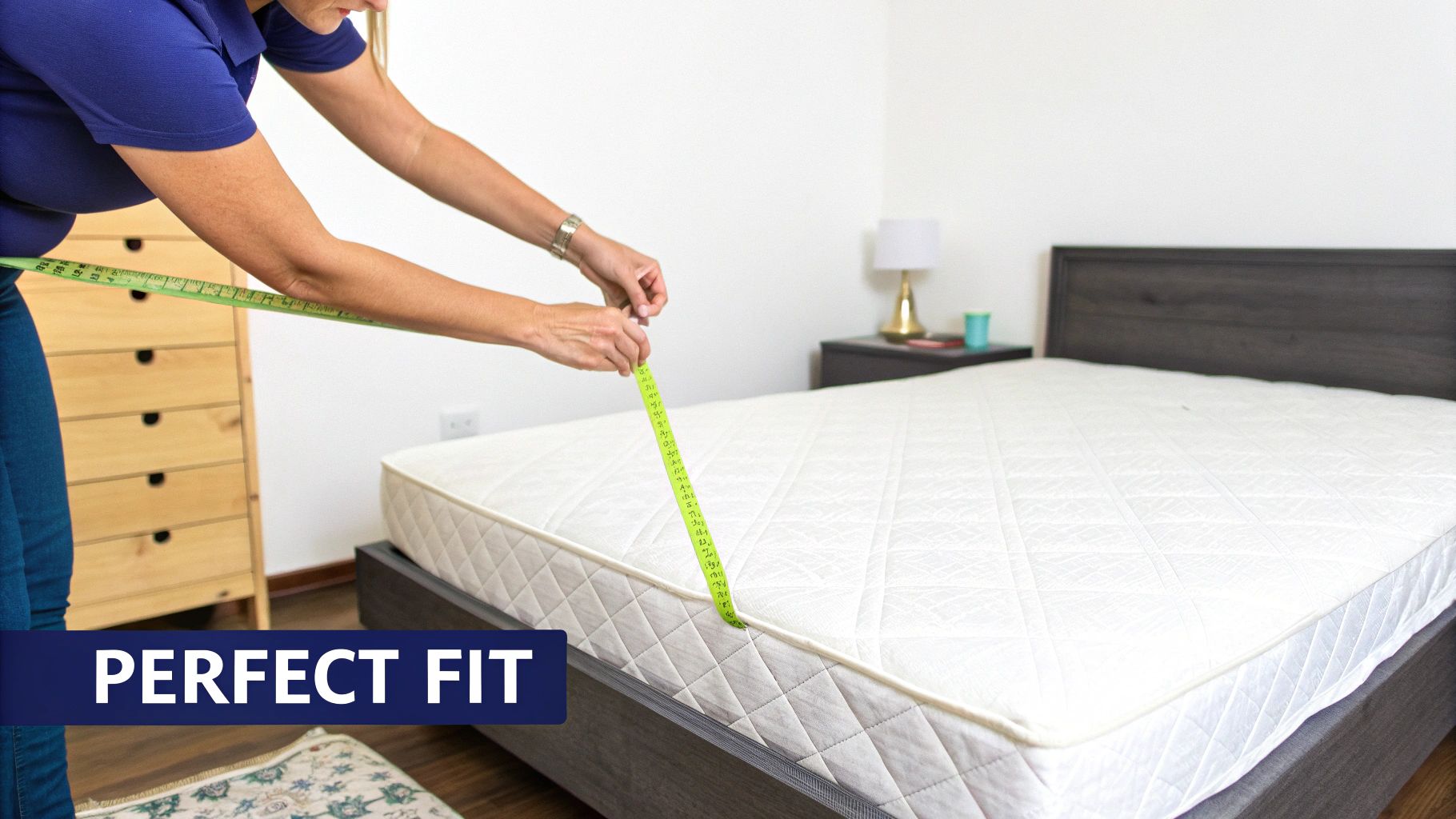Let's be honest, a good quality waterproof mattress protector in NZ isn't just an optional extra—it's essential insurance for one of the most important investments in your home. It’s the simplest, most effective way to shield your bed from spills, allergens, and moisture, keeping it clean and hygienic for years to come.
Why a Mattress Protector is Non-Negotiable in NZ
Think of your mattress as the heart of your sleep sanctuary. You wouldn't leave a new car out in the rain without a cover, so why leave your mattress exposed? A top-notch waterproof mattress protector is the single best tool you have to shield it from the realities of a busy Kiwi household.
Life happens. It might be a morning coffee that gets knocked over, a pet having an accident, or a child's nighttime mishap. Without a protective layer, those liquids don't just sit on the surface; they soak deep into the mattress fibres. This can lead to stubborn stains, funky odours, and even the growth of mould and mildew—a real concern in New Zealand's often damp climate.

More Than Just a Spill Stopper
It’s about more than just spills, though. A protector creates a healthier place to sleep. It acts as a shield, blocking common allergens like dust mites, pet dander, and pollen from settling into your mattress. If you or someone in your family suffers from allergies or asthma, this simple barrier can make a huge difference to your sleep quality.
Kiwis are catching on to just how important this is. With New Zealand's mattress market revenue expected to hit around NZ$80.77 million in 2025, it’s clear we value a good night's sleep, and products that extend the life of our mattresses are becoming more popular than ever.
A waterproof protector does more than prevent stains; it preserves the integrity and, crucially, the warranty of your mattress. A single liquid stain can void most manufacturer warranties, turning a small mishap into a very expensive problem.
Ultimately, getting the right protection is all about peace of mind. Whether you're setting up a family home, a rental property, or just trying to manage health concerns, a reliable protector is key. For those wanting more comprehensive details on waterproof mattress protectors in NZ, this guide is the perfect place to start.
We offer a great selection of options right here, so feel free to explore our full collection of mattress protectors to find the perfect one for your bed: https://nzbeds.co.nz/collections/mattress-protector.
Why Every Kiwi Home Needs a Mattress Protector
It's easy to overlook a mattress protector, but it's one of the smartest and most practical additions you can make to your bedroom. This simple layer does far more than just stop the odd spill; for Kiwi families, it's a vital tool for creating a healthier, cleaner place to sleep.
Let’s be real, New Zealand’s climate can be pretty humid. That dampness doesn't just stop at the door. We all perspire during the night, and that moisture can seep into your mattress, creating the perfect environment for mould and mildew to thrive. A waterproof protector acts as a complete barrier, stopping that moisture in its tracks and keeping your mattress fresh and dry.
A Shield Against Allergens
If you or someone in your family suffers from allergies or asthma, a mattress protector is an absolute game-changer. Over time, mattresses inevitably collect a nasty cocktail of dust mites, pet dander, and other tiny allergens that can wreak havoc on your breathing and ruin a good night's sleep.
Think of a waterproof protector as a sealed fortress for your mattress. It physically blocks these microscopic intruders from getting in, effectively cutting off your exposure to the triggers that can leave you stuffy and exhausted.
This is especially crucial for kids' beds or for anyone with a sensitive respiratory system. By keeping the mattress clean and free from this build-up, you're making a direct investment in your family's health.
Protecting Your Wallet
Now, let's talk brass tacks. A decent mattress is a big purchase, and it makes complete sense to protect it. Here's something many people don't realise: most mattress warranties become void the moment a liquid stain appears. That means one accidental spill could instantly invalidate a warranty worth thousands of dollars. Suddenly, a relatively inexpensive protector looks like an incredibly savvy investment.
Beyond the warranty, it's about making your mattress last longer. Protectors fend off the gradual damage caused by sweat, body oils, and shed skin cells, all of which degrade the mattress materials over time. It’s cheap insurance for one of your home's most important assets, whether it’s for a child’s first big-kid bed, your own bed, or keeping the mattresses at the bach fresh for guests.
A protector also gives you peace of mind against other headaches. Unwanted pests like bed bugs have unfortunately become more common in New Zealand, and they are a nightmare to get rid of. A fully encased protector creates a crucial line of defence, making it much harder for them to take hold. You can find out more about how a protector can help safeguard your home at Protect-A-Bed.
Understanding Protector Materials
When you start shopping for a waterproof mattress protector in NZ, it’s easy to focus on the ‘waterproof’ part. But what really separates a great protector from a merely functional one are the materials – both the layer you sleep on and the clever membrane doing the heavy lifting underneath.
Think of it like buying a good raincoat. You need it to keep you dry, sure, but you don't want to feel like you’re trapped in a noisy, sweaty plastic bag. A modern mattress protector strikes that same balance, delivering complete protection without compromising on a comfortable night's sleep. Let's look at the two key parts: the surface fabric and the waterproof membrane.
The Sleep Surface: What You Feel
This is the top layer, the part that sits just under your fitted sheet. It dictates the feel and comfort, and the three most common materials you’ll find in New Zealand each bring something different to the bed.
- Cotton Terry: With a soft, looped texture similar to a plush towel, cotton terry is fantastic at absorbing moisture while remaining naturally breathable. It’s a classic choice for its familiar, cosy feel.
- Bamboo: If you’re a hot sleeper, bamboo is your best friend. It’s silky-smooth, cool to the touch, and naturally hypoallergenic, making it a brilliant option for a fresh, clean sleep environment.
- Polyester: Don't let the "synthetic" label fool you. Modern polyester is engineered to be soft, quiet, and incredibly durable. It resists shrinking and is often the most budget-friendly option without feeling stiff or cheap.
The infographic below really nails down the core benefits a quality protector offers, from better hygiene to allergy relief.

As you can see, a protector's role is about much more than just spills. It's a comprehensive shield for your mattress, protecting your health and your investment.
Mattress Protector Material Comparison
To make things a bit clearer, here's a quick rundown of how these surface materials stack up against each other. Think about what matters most to you – is it a cool-to-the-touch feel, natural absorbency, or durability?
| Material Type | Key Benefit | Best For | Potential Drawback |
|---|---|---|---|
| Cotton Terry | Natural, absorbent, and breathable | A classic, comfortable feel | Can take longer to dry |
| Bamboo | Silky-smooth, cooling, and hypoallergenic | Hot sleepers and sensitive skin | Often a higher price point |
| Polyester | Durable, affordable, and quick-drying | Budget-conscious buyers and longevity | May feel less "natural" than cotton or bamboo |
This table should help you zero in on the material that best suits your sleep style and needs. Ultimately, there’s no single “best” option; it’s all about personal preference.
The Waterproof Barrier: The Unseen Hero
Tucked away beneath that comfy top layer is the real star of the show: the waterproof membrane. If you have memories of old-school protectors that were crinkly, noisy, and made you sweat, it's time to forget them.
Today’s best protectors use a micro-thin layer of polyurethane.
Polyurethane is the secret sauce. Its structure is a clever bit of science – the pores are too small for liquid molecules to get through, but just big enough to let air and water vapour escape. This means it’s 100% waterproof but also breathable, stopping heat and moisture from getting trapped while you sleep.
This technology completely busts the myth that a waterproof mattress protector has to be hot or uncomfortable. You get an invisible, silent shield against spills, sweat, and accidents without any of the crinkling noise or clammy feeling. This is especially vital for larger beds, where maintaining comfort across a bigger surface is key. If you have a bigger bed, you can learn more about finding the perfect super king mattress protector.
By picking the right combination of surface fabric and a breathable polyurethane barrier, you ensure your bed stays clean and dry without you even noticing the protector is there. It’s the ultimate win-win: total protection with a feel so good you'll forget all about it.
Key Features to Look For When Buying
Right, so you’ve got a handle on the different materials. Now it's time to dig into the nitty-gritty features that separate a decent mattress protector from a fantastic one. Think of this as your practical checklist to make sure you're getting the best bang for your buck.
First up, you need to decide on the style of the protector. This is probably the most important choice you'll make, as it directly impacts how well your mattress is covered.
- Fitted Sheet Style: This is the go-to for most Kiwi homes, and for good reason. It works just like a fitted sheet, with an elasticated skirt that hugs the corners of your mattress. It’s a breeze to whip off and throw in the wash, making it perfect for everyday protection against spills, sweat, and allergens.
- Fully Encased (Zippered) Style: This one is the full fortress. It completely encloses your mattress and zips shut, offering 360-degree protection. It's a bit more of a mission to get on, but if you're serious about keeping out bed bugs, dust mites, and other nasties, this is your best bet. It’s the top choice for anyone with severe allergies or if you're putting a mattress into storage.
Beyond the Basics: Your Non-Negotiable Features
Once you've picked a style, it's time to look at the finer details. These are the things that really make a difference to your sleep quality, so don't skimp on them.
Breathability: There’s nothing worse than a protector that makes you feel like you're sleeping on a plastic sheet. A good one will have a breathable waterproof membrane (usually polyurethane) that lets air flow freely. This stops heat from getting trapped and wicks away moisture – an absolute lifesaver during those sticky New Zealand summers.
Hypoallergenic Properties: If anyone in your family has allergies or sensitive skin, this is a must. A hypoallergenic protector creates a physical barrier against common triggers like dust mites and pet dander, which means a healthier, sniffle-free sleep. A quality Terry Cotton Mattress Protector, for instance, is naturally hypoallergenic and super absorbent.
Quiet, Crinkle-Free Fabric: Remember those noisy plastic protectors from back in the day? Thankfully, things have moved on. Modern protectors are designed to be totally silent. Keep an eye out for descriptions like "noiseless" or "crinkle-free" to make sure your protector won't announce every toss and turn.
Understanding Certifications
You'll often spot labels like Oeko-Tex on packaging or online descriptions. It’s worth paying attention to them.
An Oeko-Tex Standard 100 certification is basically a guarantee that the product has been tested for a long list of harmful chemicals and found to be completely safe. It’s peace of mind that what you and your family are sleeping on is clean and healthy.
This focus on hygiene isn't just a local trend. The global mattress protector market was valued at about USD 3.31 billion in 2024 and is expected to nearly double to USD 6.61 billion by 2035, largely because people are demanding safer, cleaner bedding materials.
By keeping these key features in mind, you'll be well-equipped to find a waterproof mattress protector in NZ that’s a perfect match for your bed and your family.
Finding the Perfect Fit for NZ Mattress Sizes
There's nothing more annoying than a mattress protector that bunches up or pings off the corners in the middle of the night. It's not just frustrating; it means your mattress isn't getting the full protection you paid for. Getting the fit right is absolutely essential, especially with the huge range of mattress depths on the market here in New Zealand.
Knowing whether you have a Queen or a King is just the start. The real game-changer for a perfect fit is measuring the height of your mattress.

Many of the mattresses we love today, like those plush pillow-tops or comfy memory foam ones, are much deeper than older, more traditional styles. This extra height is a common culprit for ill-fitting protectors – a standard one just won't have enough fabric to tuck securely underneath, leading to those corners constantly popping off.
Measuring for a Snug Fit
Before you even think about clicking "add to cart," grab a tape measure. Measure your mattress from the very bottom edge to the absolute highest point on its top surface. Be gentle and don't squash it down; you need the measurement of its full, natural height.
Once you have that number, add an extra 5cm. This little bit of 'give' ensures the protector has enough fabric to wrap firmly under the mattress, keeping it locked in place.
For example, if your mattress measures 35cm deep, you should be looking for a protector that can handle a depth of at least 40cm. That extra allowance is the secret to a tight, slip-free fit that won't budge.
With your measurements in hand, you can shop with confidence. Keep an eye out for these terms in product descriptions to know you're on the right track:
- Deep Pockets: This is a clear sign the protector is made for thicker, modern mattresses.
- Stretchable Skirt: A good, stretchy elasticated skirt is designed to hug the sides of your mattress nice and tight.
- Fits Mattresses Up To Xcm: This is the most straightforward info you can get. Just make sure your required depth (your mattress height + 5cm) is covered.
Taking the time to choose the right size means your protector will stay exactly where it's meant to be, giving you seamless comfort and total peace of mind. For a complete rundown of standard bed dimensions, have a look at our comprehensive NZ mattress size guide. It'll help you match everything up perfectly.
Care and Maintenance: Keeping Your Protector in Top Shape
So, you’ve brought home a quality waterproof mattress protector. Great choice! A little bit of TLC is all it takes to make sure it protects your mattress for years to come. Think of it as simple upkeep to preserve that crucial waterproof barrier and keep your bed fresh and hygienic.
Regular washing is a must. For most Kiwi households, popping it in the wash once a month with your other bedding is a good rule of thumb. If you’re dealing with allergies, though, you might want to wash it every week or two to keep on top of dust mites and other nasties.
Washing and Drying Done Right
Here’s the golden rule: high heat is the enemy. Seriously. Heat can wreck the delicate waterproof membrane, causing it to crack or blister, which completely defeats the purpose of having a protector in the first place.
Stick to these simple steps, and you can’t go wrong:
- Gentle Machine Wash: Use a gentle cycle with cold or warm water. Always double-check the care label, but whatever you do, avoid hot water.
- Mild Detergent Only: A little bit of gentle, bleach-free detergent is all you need. Harsh chemicals and bleach will only damage the waterproof layer over time.
- Skip the Fabric Softener: Fabric softeners might seem like a good idea, but they can clog the pores of the fabric, which stops it from breathing properly.
- Low and Slow Drying: If you’re using a dryer, always choose the lowest heat setting. Even better, line drying is the safest and gentlest option for your protector.
A classic mistake is throwing the protector in with a load of towels. The heavy fabric creates too much friction and can trap heat in the dryer, which is bad news for that delicate waterproof lining. It’s much safer to wash it with lighter items, like your sheets.
Of course, accidents are bound to happen. When they do, act fast. Blot up any spills straight away with a clean cloth to soak up as much liquid as you can. Your protector will stop it from reaching the mattress, but you still need to deal with the spill itself. For tougher odours, you might find these effective tips for getting urine smell out of clothes handy for cleaning the protector too.
Following these simple care instructions will make all the difference, helping your waterproof mattress protector nz do its job and keeping your bed a healthy place to be.
Your Questions Answered
It's completely normal to have a few questions when you're looking for the right bedding. Let's tackle some of the most common queries we hear from Kiwis, so you can choose the perfect waterproof mattress protector with total confidence.
Will It Make Me Hot at Night?
This is probably the number one concern, and a fair one! Many of us remember the old-school protectors that felt like sleeping on a plastic bag. Thankfully, those days are long behind us.
Today's protectors are a world away from that. They use a special polyurethane membrane instead of old, crinkly vinyl. This modern material is a bit of a game-changer – it's fully waterproof but also breathable. This means air can still move freely, stopping heat from getting trapped under the covers. When you combine this smart tech with a soft top layer like cotton or bamboo, you get a cool and comfortable sleep, even on a sticky summer night.
Fitted or Fully Encased?
Choosing the right style really just depends on what you need it for. For most Kiwi homes, the fitted sheet style is the go-to choice and works brilliantly.
- Fitted Style: This type slips on just like a standard fitted sheet, making it super easy to whip off for a wash. It provides excellent protection against the usual suspects – spills, sweat, and allergens.
- Fully Encased Style: This is a full, zippered bag that seals your entire mattress, offering complete 360-degree protection. It's the ultimate defence against bed bugs and is also a fantastic option if you're putting a mattress into storage or dealing with severe allergies.
Can I Put It in the Dryer?
Yes, you can! Most modern protectors are designed to handle the tumble dryer, but there's one golden rule: always use a low heat setting. Blasting it with high heat can damage or even melt the waterproof backing, which would make it pretty useless.
Before you toss it in, always have a quick look at the care label on your specific protector. It’s also a good idea to skip the fabric softeners and dryer sheets, as they can leave a film that clogs the membrane and makes it less breathable over time. For more answers to your bedding questions, check out our detailed FAQs page.
Ready to find the perfect shield for your mattress? At New Zealand Bed Company, we offer a wide selection of high-quality waterproof mattress protectors designed for Kiwi homes. Protect your investment and enjoy a cleaner, healthier sleep.

